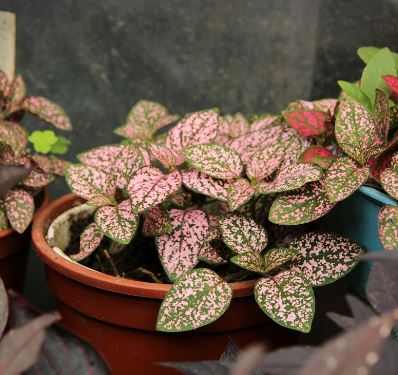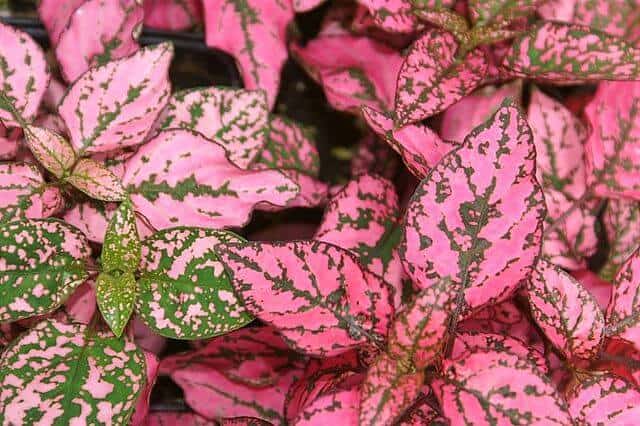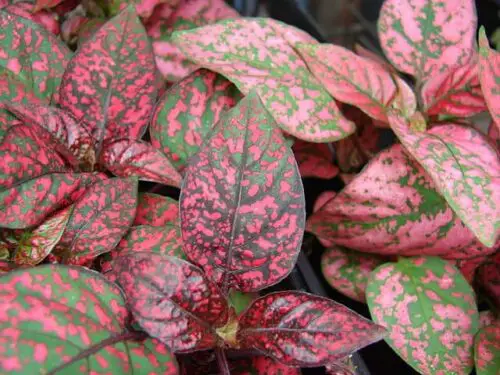Pink Polka dot plant (hypoestes phyllostachya) is one such varieties of this plant which looks amazing as they are different in color but everything is similar. Caring needs of this plant is common as polka dot’s and it also has dotted foliage that looks fantastic. I love how these plants are perfect for a miniature or placed indoors for ornamental purposes. Polka dot comes in many other colors having combinations of white and green, pink and green , green and red. If you have these 3 varieties You may have seen all have deep colors that make them more beautiful. Generally they are eye-catching and absolutely the best plants to grow indoors. Easy to grow, easy to care just follow the instructions and you are good to go.
Polka dot plant symbolism
Polka dot plant symbolic meaning : The Greek words “hypo,” which means “under,” and “estia,” which means “house,” are the origin of the term Hypoestes. This term alludes to the plant’s concealed blooms that are found behind its fused bracts. According to Feng Shui principles, the plant represents both cleanliness and uplifting energy. It serves as a reminder of the many ways that nature may promote wellness.
The polka dot plant receives its name from the pink polka dots that develop on its leaves, which resemble a polka dot pattern. This beauty is a distinctive and lovely plant with red, pink, or white foliage accented with dark green splotches. The polka dot plant is a flexible plant for any interior environment because to its extensive hybridization, which results in a variety of colors and patterns.
The polka dot plant has medical qualities in addition to being beautiful. The leaves are used to alleviate pain, inflammation, and fever in conventional medicine. The plant may potentially include antibacterial qualities that aid in preventing bacterial infections.
Some people think that plants have spiritual significance and may infuse our lives with uplifting energy. The polka dot plant represents cleanliness, excellent health, and uplifting energy. It may be used to Feng Shui to create harmony and balance in a location.

Pink Polka dot Care
Soil
Pink polka dot plants grow well in potting mix having organic matter included in it. Mixing 20% perlite for drainage can be useful or you can also use pumice or peat moss. I am using This All purpose soil, You can check out .
Light
Generally these plants prefer indirect light and if you grow them outdoors make sure to put them in a place where there is shade like below a tree. If you give them direct sunlight it may burn some of the foliage. Indoors you can place them near the window, South facing is good. Still Give them partial sunlight if they are indoors or outdoors as it helps the foliage to be healthy.
Here is the link to Buy Pink Polka dot plant –

Water
Remember Polka dot doesn’t like overwatering and underwatering so give them water to make them evenly moist and they like being on moist soil. Also Every 2 days check for dryness and don’t pour water if they haven’t dried out. You can check top 1 inch soil for dryness only if they feel water is less give them. Plant thats thrives indoors in a pot needs consistent watering and also checking it for water logging. Outdoors there is sunlight and wind which generally dries the soil but if you live in a cold climate area then watering is not very frequent in those places. For Winters You can minimize the watering 50% , Now give water in every 7 -9 days if they feel dried out. Once Spring starts Resume follow your routine for watering.
Pests
Polka dot plants generally attacked by mealybugs the popular bug in every plant and whiteflies and aphids. Holes in leaves, discolored leaves are some of the signs even you can find stems getting unhealthy. Pests Problem occur mostly Indoors and root rot is also an issue inside as overwatering damages the root system of the plant. You can use pesticide to get your polka dot out of this situation.
Fertilizer
These plants need fertilizer every month when they are in the growing phase and use a liquid based plant food to feed them. Also In Growing season, Soil with Organic Compost are used to provide them nutrients so it thrives healthy. Here is the All Purpose fertilizer I am using – Check Price.
Temperature
They like warm temperature and ideally live in 65-80 degree F and you can shift it indoors in winters as temperature might drop to below 30 degree F and it is not a healthy level. In Spring it can be grown outdoors as they like to sit in an outside environment with bright light as they have handled frost so they need to be in good condition for some days. Pink Polka dot can tolerate low to moderate humidity and you can always check soil before watering as the soil might become soggy if you overwatered and didn’t check the soil.

Pink Polka Dot Plant Propagation
Stem cuttings are one method by which the pink polka dot plant may be propagated. Here are some actions to take:
- Choose a stem that is at least 4 inches long, healthy, and has numerous leaves.
- Just below a node, cut the stem. (where the leaf meets the stem).
- The lowest 2 inches of the stem should be free of leaves.
- Apply rooting hormone to the stem’s cut end.
- In a container with damp potting soil, plant the stem.
- To make the atmosphere humid, wrap a plastic bag around the pot.
- Keep the soil wet and place the container in a bright, indirect light.
- The stem should begin to form roots after a few weeks.
- You may move the plant to a bigger container after its roots have grown deeply.
Pink Polka Dot Plant Name
The pink polka dot plant’s scientific name is Hypoestes phyllostachya. It is also known as the freckle face plant, splash plant, and measles plant, among other names.
Pink Polka Dot Plant Seeds
From seeds, the pink polka dot plant may be propagated. However, finding seeds for this plant might be challenging. If you do discover seeds, do the following actions:
- Put wet potting soil in a container.
- On the soil’s surface, scatter the seeds.
- Soil is used to softly enclose the seeds.
- Keep the soil wet and place the container in a bright, indirect light.
- The seeds should begin to sprout after a few weeks.
You may transfer the seedlings to separate pots after they have sprouted a second set of leaves.
Pink Polka Dot Plant Toxic to Cats

Yes, pink polka dot plant is toxic to cats. It includes a compound called saponin, which, if consumed, may result in nausea, diarrhoea, and other gastrointestinal issues. Keep this plant out of the reach of cats if you have them, or find a non-toxic substitute.
Pink Polka Dot Plant Near Me
A common indoor plant that can be found in plenty of nurseries and garden shops is the pink polka dot plant. This plant is also available from a number of shops online. You may use a search engine or gardening app to look for a nursery or merchant nearby by entering “pink polka dot plant near me.” You may also discover whether this plant is available at nearby nurseries and garden centers.
Some varieties of Polka dot Plants
- Pink Brocade – It has pink spots just like the name suggests the color and green foliage.
- Confetti – These have different color spots including reddish, pinkish, rose or white and foliage is green.
- Splash Series – It has a combination of 2 colors like spots of red, white , pink with green leaves.
- Camina – It has red spots and a very darkish green mix.
If Pink Polka dot Plant becomes leggy?

Basically if pink polka dot’s become leggy then it is not a good sign for its overall growth; this might kill your plant so pinching off some of the stem shows legginess. Pruning is the only way to solve this problem and it also encourages healthy bushy growth. Even after that your might become compact will look good and can attract more eyes.
Here is full detailed information on solving leggy polka dot plant.
As you know this plant is the same as the main polka dot plant so care is almost the same.
Here You can read Polka dot plant Care and For propagation here.
Pink Polka Dot Plant Indoor Care
Hypoestes phyllostachya, sometimes known as the pink polka dot plant, is a stunning and well-liked indoor plant. Here are some maintenance advice to maintain your plant in good health:
Light
Bright, indirect light is preferred by the pink polka dot plant. The leaves are susceptible to damage and burning from direct sunshine. You may also utilize artificial light to maintain the health of your plant if the region is not well-lit.
Watering
The pink polka-dot plant like being kept damp but not soggy. When the top inch of soil on your plant feels dry to the touch, water it. Avoid overwatering your plant as this might cause root rot.
Humidity
High humidity is preferred by the pink polka dot plant. By putting a tray of water next to your plant, spraying it often, or using a humidifier, you may raise the humidity level.
Warm temperatures between 65°F and 75°F (18°C and 24°C) are preferred by the pink polka dot plant. Keep your plant away from radiators, air conditioners, and other heat or cold sources.
Soil The pink polka dot plant prefers an organically rich, well-draining soil. You may use potting soil that has been created with indoor plants in mind.
